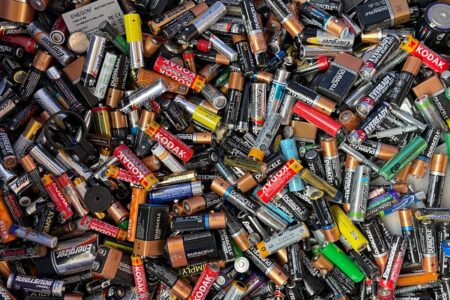Introduction
At least among the uninitiated, the need for hazardous waste disposal usually evokes images of some random cocktail of spent chemicals bubbling & perking in a 55-gallon drum, hidden behind an industrial-strength widget factory shrouded in a purplish smog.
But au contraire…
Many hazardous wastes are composed of everyday materials that we regard as largely benign when it comes to the environment. Think: batteries, pesticides, fluorescent tubes, aerosol cans, televisions, computers, old thermostats—the list goes on.
Thus, the EPA created the Universal Waste subcategory for certain kinds of hazardous waste that are commonly generated by households, businesses, and industry—along with regulations that purportedly streamline the hazardous waste management rules that surround them.
The agency says it did so to promote the collection and recycling of universal waste and encourage the development of municipal and commercial programs to reduce the amount of it that’s landfilled or incinerated.
It also purports that it created the Universal Waste subcategory to ease the regulatory load on retail stores and other generators needing to collect and transport such waste to a treatment facility.
What exactly constitutes universal waste?
If you suffer from insomnia, the Federal Universal Waste Regulations found in Title 40 of the Code of Federal Regulations might be a cure. But before you drop off, pay special attention to Part 273, which applies to the five types of universal waste. They are:
- Batteries (guilty for containing lithium, silver ion, nickel, cadmium, mercury-oxide, or sealed lead-acid) [CFR § 273.2]
- Pesticides (guilty for the toxicity of their constituent chemicals) [CFR § 273.3]
- Mercury-containing (E.g., thermometers, thermostats, and various equipment) [CFR § 273.4]
- Lamps (such as fluorescent, high-intensity discharge, neon, mercury vapor, high-pressure sodium, and metal halide) [CFR § 273.5]
- Aerosol cans (guilty for containing VOCs that contribute to the formation of ground-level ozone) [ CFR § 273.6}
State-specific universal wastes
Complicating matters, any state can specify additional materials for its universal waste program, meaning that what’s a universal waste in one state might be hazardous waste in another—and you really don’t want to have a hazardous waste found in your universal-waste stream.
You can see a detailed list of state-specific universal wastes here. Nonetheless, as we’re apt to counsel: get expert advice before you start throwing stuff away en masse.
Hazardous- vs. universal-waste regulations
To begin, EPA regulations are specific to the type of universal waste under consideration, and they’re different for small vs. large universal waste handlers. Again: it’s imperative to get expert advice.
Also, the EPA specifies that universal waste must be managed to prevent its release into the environment. Thus, universal waste handlers are required to have an emergency plan for unintended release—just like for hazardous waste.
In general, universal waste can be stored for a year, and accumulations aren’t added to hazmat counts in determining whether a hazmat generator is “small” or “large.” You can still be a “very small” hazmat generator, even if you have 5000+ kg of universal waste onsite.
As to storage:
- Small-quantity handlers of universal waste can accumulate up to (but fewer than) 5000 kg of the staff onsite. Large-quantity handlers of universal waste can accumulate as much as they want. And for both large and small—up to a year without a storage permit.
- In contrast, small-quantity generators of hazardous waste have up to (but fewer than) 270 days to get the stuff offsite, while large-quantity generators of hazardous waste enjoy less than 90 days to get all that hazmat out of Dodge.
Standards for universal waste also include requirements for labeling, but EPA identification numbers are not required for universal waste handlers, be they small or large. Of course, such numbers are very much required of all small and large hazardous waste generators (although not for “very small” ones).
Transportation rules for universal waste
The DOT rules for universal waste transporters are logically more lenient than the rules for hazardous waste transporters. And unlike small or large hazardous-waste generators, hazardous waste manifests aren’t required for universal waste handlers (although large handlers are required to keep basic shipping records).
“Cradle-to-grave” considerations
Remember that materials categorized as universal waste are nonetheless hazardous waste and ultimately must wind up in a facility that’s “permitted” to treat, recycle, or otherwise dispose of hazmat. The EPA is not cool with you just throwing it into a dumpster.
Also, bear in mind that one of the imperatives of the RCRA is that you’re responsible for any hazardous waste you generate, from “cradle-to-grave,” including its generation, transportation, treatment, storage, and disposal.
Thereby, you’re not only accountable for hazardous waste from the moment it’s generated; you’re also legally responsible for its safe transportation to wherever it will be ultimately processed or disposed of.
The upshot
In concert with state and local agencies, the EPA makes it remarkably easy to be a hazardous waste generator, whether such waste is initially considered “universal” or not. Consider this story that we’ve commented upon before:
Roughly five years ago, Whole Foods was fined by the EPA for how its individual stores disposed of customer returns and out-of-date products that were no longer shelf-worthy. They were seemingly innocuous out-of-date or unsellable goods dumped into the trash. And since there was no criminal intent, the issue was congenially settled for a mere $3.5 million.
The settlement tossed the ecologically self-conscious Whole Foods into the same shopping cart with Wal-Mart, which perpetrated a similar brand fiasco upon itself some years prior, coughing up $81 million to make nice with the EPA.
To know more, please check Pegex.
